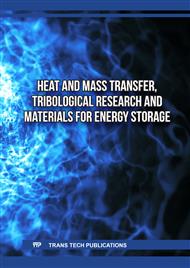[1]
S. Lee, S.U.S. Choi. Application of Metallic Nanoparticle Suspensions in Advanced Cooling Systems. International Mechanical Engineering Congress and Exhibition, Atlanta, USA. 342 (1996) 227–234.
Google Scholar
[2]
M. Shafahi, V. Bianco, K. Vafai and O. Manca. Thermal Performance of Flat-Shaped Heat Pipes Using Nanofluids. International Journal of Heat and Mass Transfer. 53, 7-8 (2010) 1438 – 1445.
DOI: 10.1016/j.ijheatmasstransfer.2009.12.007
Google Scholar
[3]
K. Khanafer, K. Vafai, M. Lightstone, Buoyancy-driven heat transfer Enhancement in a two-dimensional enclosure utilizing nanofluids. Int J of Heat and Mass Transfer. 46 (2003) 3639–3653.
DOI: 10.1016/s0017-9310(03)00156-x
Google Scholar
[4]
H.C. Brinkman. The viscosity of concentrated suspensions and solution. J. Chem. Phys. 20 (1952) 571–581.
Google Scholar
[5]
I. Lahlal, S. Daoudi, K. Amghar, D. Bahia. Improving Natural Convection in a Nanofluid Filled Cavity Through SMART Numerical Simulation. In International Conference on Smart Medical, IoT & Artificial Intelligence,Cham: Springer Nature Switzerland. (2024) 99-105.
DOI: 10.1007/978-3-031-66854-8_10
Google Scholar
[6]
R. Bennacer, M. El Ganaoui, T. Maré, and C. T. Nguyen. Natural convection of nanofluids in cavity including the soret effect. Computational of Thermal Sciences. 4 (2009) 425– 440.
DOI: 10.1615/computthermalscien.v1.i4.40
Google Scholar
[7]
M. El hattab, R. Mir, Y. El hammami, T. Mediouni. Simulation numerique de la convection naturelle des nanofluides dans une enceinte carrée chauffée par une source de chaleur. Revue Internationale d'héliotechnique. 45 (2013) 51-59.
Google Scholar
[8]
H. Salhi, M. Si-Ameur. Convection naturelle dans les enceintes: nanofluide. Revue des Energies Renouvelables. 15(2012) 121 – 130.
DOI: 10.54966/jreen.v15i1.306
Google Scholar
[9]
M. Corione, A. Quintino. Double-Diffusive Effects on the Onset of Rayleigh-Benard Convection of Water-Based Nanofluids. Appl. Sci. 2022, 12, 8485.
DOI: 10.3390/app12178485
Google Scholar
[10]
C.J. Ho, W.K. Liu, Y.S. Chang and C.C. Lin. Natural Convection Heat Transfer of Alumina–Water Nanofluid in Vertical Square Enclosures: An Experimental Study. International Journal of Thermal Sciences. 49 (2010) 1345 – 1353.
DOI: 10.1016/j.ijthermalsci.2010.02.013
Google Scholar
[11]
R. Rudrabhiramu, K.K. Kupireddi, K.M. Rao. Study of Thermal Characteristics Augmentation of the Aluminium Oxide Nano Fluid with Different Base Fluids. International Journal of Heat and Technology Vol. 39, No. 6, December, 2021, pp.2000-2005.
DOI: 10.18280/ijht.390639
Google Scholar
[12]
M. Ouakarrouch, K. El Azhary, N. Laaroussi, M. Garoum. Three-dimensional numerical simulation of conduction, natural convection, and radiation through alveolar building. Case Studies in Construction Materials. Volume 11, December 2019, e00249.
DOI: 10.1016/j.cscm.2019.e00249
Google Scholar
[13]
M. Hosseini, M.T. Mustafa, M. Jafaryar, E. Mohammadian. Nanofluid in tilted cavity with partially heated walls. Journal of Molecular Liquids volume. 199 (2014) 545–551.
DOI: 10.1016/j.molliq.2014.09.051
Google Scholar
[14]
J. C. Maxwell-Garnett, "Colours in metal glasses and in metallic films," Philosophical Transactions of the Royal Society A: Mathematical, Physical and Engineering Sciences. 203(1904) 385–420.
DOI: 10.1098/rsta.1904.0024
Google Scholar
[15]
S.M. Aminossadati, B. Ghasemi, Natural convection cooling of a localised heat source at the bottom of a nanofluid-filled enclosure. European Journal of Mechanics B/Fluids .28 (2009) 630– 640.
DOI: 10.1016/j.euromechflu.2009.05.006
Google Scholar
[16]
O. Ghoulam, H. Talbi, K. Amghar, A. Amrani, A. Charef, I. Driouch. Heat transfer improvement in turbulent flow using detached obstacles in heat exchanger duct. International Journal of Thermofluids. 27 (2025), 101225.
DOI: 10.1016/j.ijft.2025.101225
Google Scholar
[17]
O. Hakan F., and E. Abu-Nada. Numerical study of natural convection in partially heated rectangular enclosures filled with nanofluids. International journal of heat and fluid flow 29.5 (2008) 1326-1336.
DOI: 10.1016/j.ijheatfluidflow.2008.04.009
Google Scholar
[18]
G. Barakos, E. Mitsoulis. Natural convection flow in a square cavity revisited: laminar and turbulent models with wall functions. Int. J. Num. Meth. Fluids .18 (1994) 695–719.
DOI: 10.1002/fld.1650180705
Google Scholar
[19]
N. Putra, W.Roetzel, S.K. Das, 2003. Natural convection of nanofluids. J. Heat Mass Transfer, 39, pp.775-784.
DOI: 10.1007/s00231-002-0382-z
Google Scholar
[20]
K. Amghar, A. Filali, M.A. Louhibi, H. Bouali, N. Salhi, M. Salhi. Numerical study of turbulent heat transfer in a horizontal channel provided with square blocks: Effect of the inter-block spacing. Journal of thermal Engineering, 7, pp.650-665 (2021).
DOI: 10.18186/thermal.890073
Google Scholar
[21]
O. Ghoulam, H. Tlabi, K . Amghar, A. Amrani, I. Driouch. Heat transfer improvement in turbulent flow using detached obstacles in heat exchanger duct. International Journal of thermofluids, 27, 10.1016/j.ijft.2025.101225 (2025).
DOI: 10.1016/j.ijft.2025.101225
Google Scholar
[22]
K.Amghar, H. Ameur, H. Bouali, N. Salhi. Numerical study of thermal and dynamic structure of a laminar flow in solar collector. Materials Today: Proceedings, 45, p.7501–7506 (2021).
DOI: 10.1016/j.matpr.2021.02.258
Google Scholar
[23]
E. Abu-Nada, Z. Masoud, A. Hijazi, 2008. Natural convection heat transfer enhancement in horizontal concentric annuli using nanofluids, 35, p.657–665.
DOI: 10.1016/j.icheatmasstransfer.2007.11.004
Google Scholar
[24]
I. Ahmad Faris,R. Welvakar, M. Khalid, 2003.Numerical Study on Buoyancy Driven Heat Transfer Utilizing Nanofluids in a Rectangular Enclosure, In Proceedings of the UK-Malaysia engineering conference (pp.118-123).
Google Scholar


